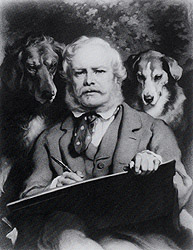|

Original works of art
|
| Sir Edwin Landseer |
| (English, 1802 -1873 ) |
Edwin Landseer was the pre-eminent animal artist of the nineteenth century,
an artist of precocious talent who had produced a body of work by his mid-twenties
which would outshine the entire output of many of his contemporaries.
The youngest boy in a family of seven children, his talent as well as his good
looks made him a favorite. Nor was he the only artist in the family, for his
sisters, Jessica and Emma, were painters of miniatures, his elder brother Charles
was a painter and Thomas followed in his father's footsteps to become an engraver.
Edwin Landseer was a precocious child and created accomplished drawings at the
age of four. Even at this early age he was very fond of animals. His earliest
drawings were actually done under his mother's supervision, but when his father
recognized his child's talent, he took over his instruction in art, starting
a relationship that was very successful. The early years of Landseer's life
are marked by one extraordinary accomplishment after another.
In 1815, at the age of thirteen, Edwin was awarded a silver medal by The Society
of Arts for his drawing of a hunter, the same year in which he made his first
contributions to the annual exhibitions at The Royal Academy. After working
under B.R. Haydon, who encouraged him to study anatomy, Landseer was in 1816
formally admitted to the Royal Academy schools, where he stayed for about three
years. By 1817, at the age of fifteen, he was a regular exhibitor at the Royal
Academy's annual exhibitions as well as at the Society of Painters in Oil and
Watercolor. At the precociously young age of twenty-four he was elected as an
Associate of The Royal Academy. In 1831 he was elected to full membership. In
1865 he was elected President of the Royal Academy, but refused the honour due
to ill health. He exhibited 179 works at the Royal Academy.
Landseer was undoubtedly influenced by other English as well as Continental
European artists. He was aware of the work of such English artists as George
Stubbs, and the 19th century painters, Philip Reinagle and James Ward. His greatest
influence, however, was undoubtedly the work of the seventeenth century Dutch
and Flemish artists. Several of his compositions resemble the work of Frans
Snyders, and he actually copied works by Peter Paul Rubens. Richard Ormond has
pointed out that, “ A general revival of interest in seventeenth century
Flemish painting was reflected in the early part of the nineteenth century,
both in contemporary criticism and in the art Market... The Flemings in a grander
scale, and with greater dramatic force, provided a general point of reference
for Landseer.”
By his early twenties Landseer was an established artist with a quickly developing
roster of patrons. And while he is most closely associated with Queen Victoria,
by the 1820's Landseer was well-known for his portraits of animals and children
among a small but important group of aristocratic patrons. In 1836 Landseer
painted the first breed most closely associated with the Queen: Dash depicts
the young princess' favorite pet, a Toy Spaniel. Dash was a black and white
dog with tan eyebrows, or what is now known as a the tri-color or Prince Charles,
in distinction from the black and tan King Charles, red and white or lemon and
white Blenheim and the Ruby, which were all recognized varieties in 1839.
Images such as “Dash” had immense popular appeal, and although Landseer
himself had mixed feelings about it, the majority of his paintings were reproduced
as engravings during his lifetime, or shortly after. The process of engraving
or having another artist in effect copy a popular artists painting was common
practice in the nineteenth century, and it served to enhance an artists reputation
and popularize his work. There were also significant commercial considerations
in the production of such prints, for artists could often sell the reproduction
rights of a popular image for more than the price of the original painting.
Many Victorian painters did this, but as Landseer’s images were so popular
with the general public, he benefitted more than others.
Landseer was closely associated with the Royal Family and the Scottish Highlands
which they first visited in 1842, some eighteen years after Landseer, and one
can imagine that it must have had a strong effect on the royal couple. The Queen's
physician Sir James Clark had recommended the Highlands for its bracing, pure
mountain air. Staying with Lord Breadalbane at Taymouth Castle for their first
visit, the couple was enchanted. "Scotland has made the most favorable
impression on us both," wrote Prince Albert, " The country is full
of beauty, of a severe and grand character; perfect for sport of all kinds,
and the air remarkable pure and light in comparison with what we have here."
Balmoral, which itself became too small as the Royal family grew, was bought
with its 1,700 acres from the Earl of Fife in 1842. The new, enlarged castle
was designed by the Prince himself, and was started in September of 1853. It
was in the Scottish Highlands that many of Landseer's most popular scenes were
painted. The artist had been visiting Scotland since 1824 when at a young age
he had gone to visit Sir Walter Scott. The artist continued to visit Scotland,
going virtually every year thereafter. Inspired by the breathtaking landscape
and the vigorous lifestyle of the Scottish Highlands, his sojourns must have
provided a much needed respite from the hurried pace of London. Landseer depicted
the hunt in all its aspects in great detail, and completed quite a few dog portraits
per se. Many watercolors were completed which depicted Royal life in the Highlands.
These were often brought back home to Windsor to be fitted into large albums.
|

